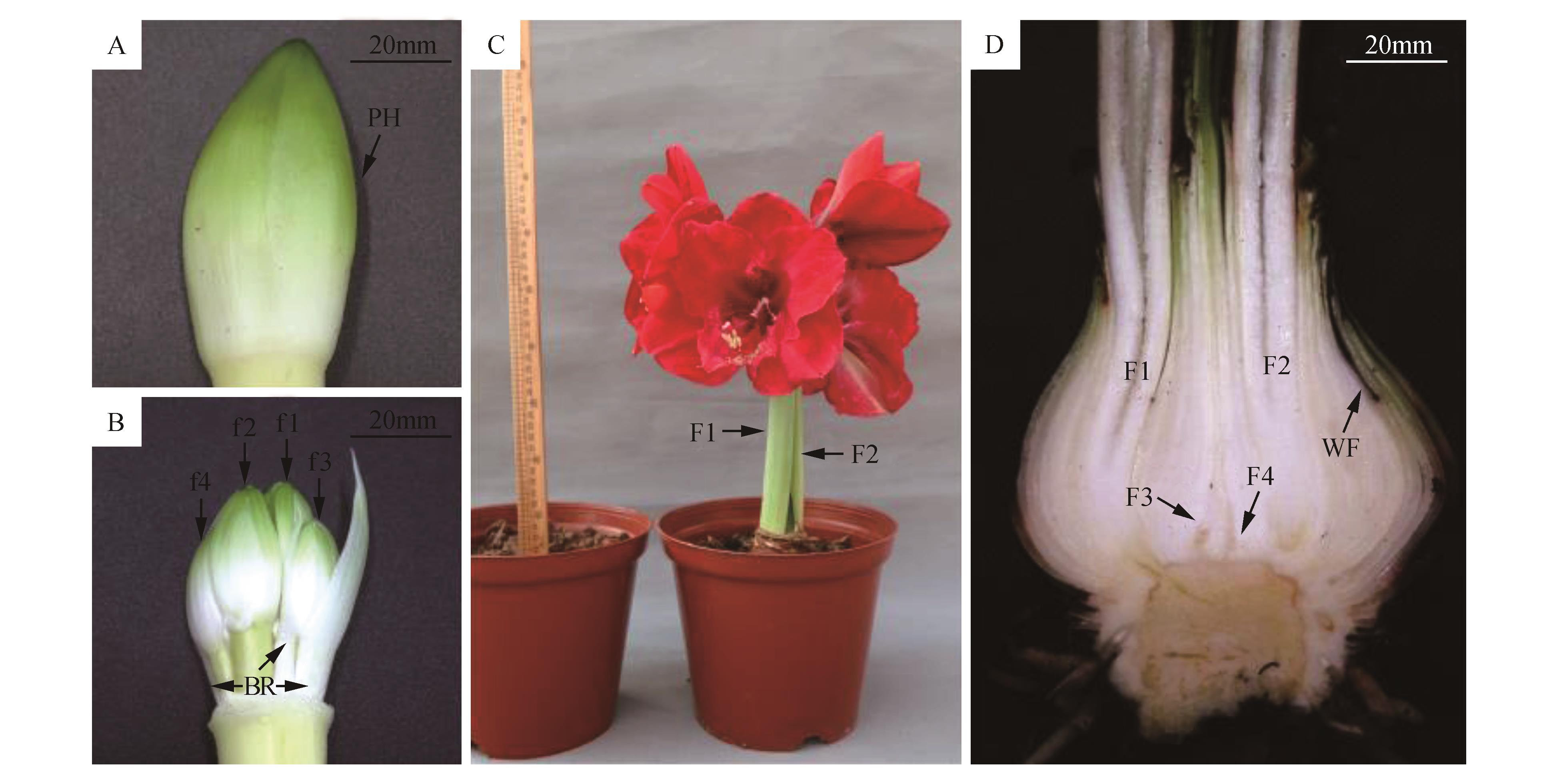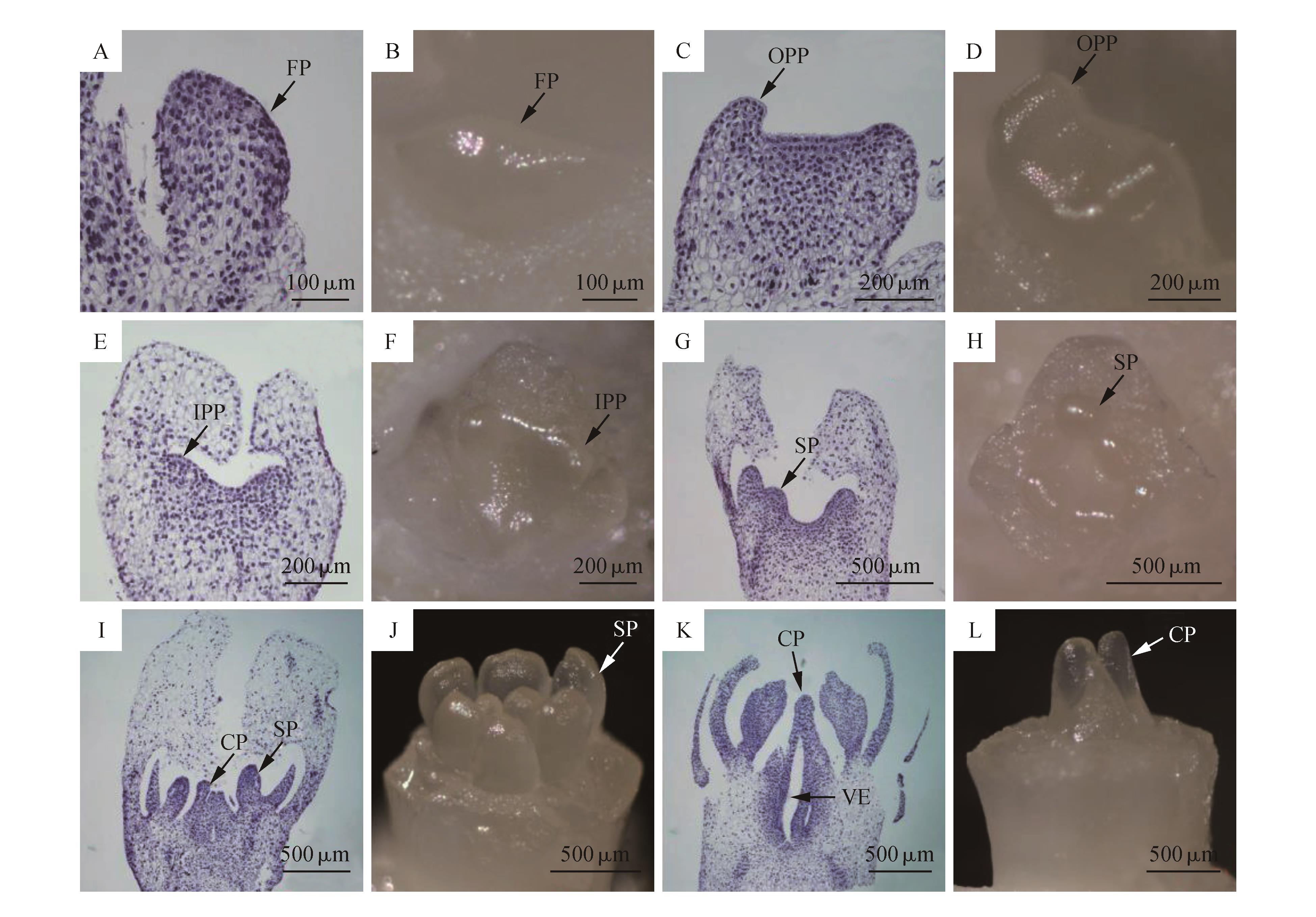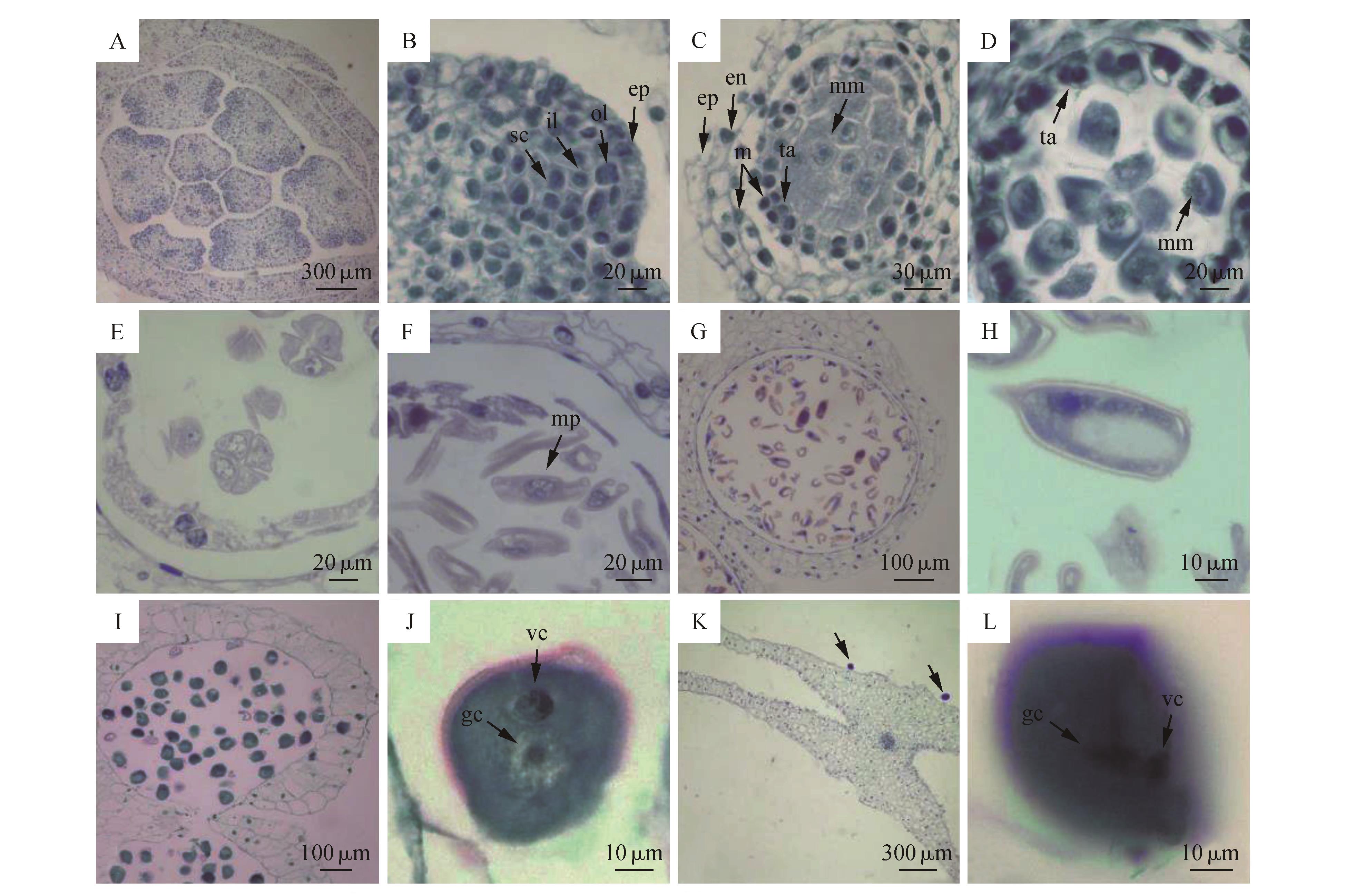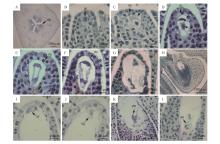Bulletin of Botanical Research ›› 2022, Vol. 42 ›› Issue (1): 12-20.doi: 10.7525/j.issn.1673-5102.2022.01.002
• Research Report • Previous Articles Next Articles
Xin Li, Liuyan Yang, Zhen Wang, Yi Sun, Junxu Xu, Yongchun Zhang( )
)
Received:2020-10-15
Online:2022-01-20
Published:2021-12-30
Contact:
Yongchun Zhang
E-mail:saasflower@163.com
About author:LI Xin(1986—),female,assistant researcher,engaged in researches of development and physiology of flowering plants
Supported by:CLC Number:
Xin Li, Liuyan Yang, Zhen Wang, Yi Sun, Junxu Xu, Yongchun Zhang. Flower Bud Differentiation of Hippeastrum hybridum ‘Merry Christmas’[J]. Bulletin of Botanical Research, 2022, 42(1): 12-20.
Add to citation manager EndNote|Ris|BibTeX
URL: https://bbr.nefu.edu.cn/EN/10.7525/j.issn.1673-5102.2022.01.002

Fig.2
Schematic diagram of the inflorescence structure and position in H. hybridum ‘Merry Christmas’A-B.Inflorescence morphology and internal structure diagram during bud stage;C-D.Schematic diagram of inflorescence position in bulb during flowering period(C.Inflorescence in bloom;D.Longitudinal section of bulb);PH.Phyllary;BR.Bracteole;f1-f4.The first to the fourth flower bud from large to small in the inflorescence;F1.The first inflorescence in bloom in the current year;F2-F4.Taking F1 as the first,the second to the fourth inflorescence from the outer layer to the inner layer of the bulb;WF.Withered inflorescences in the previous year


Fig.4
Morphological differentiation of the flower organs in H. hybridum ‘Merry Christmas’A,C,E,G,I,K.Paraffin longitudinal section of flower buds with lengths of 0.02,0.05,0.1,0.2,0.3,0.4 cm;B,D,F,H,J,L.Anatomy observation of flower buds with lengths of 0.02,0.05,0.1,0.2,0.3,0.4 cm;A-B.Flower primordium differentiation stage;C-D.Outer perianth differentiation stage;E-F.Inner perianth differentiation stage;G-H.Stamen differentiation stage;I-J.Carpel differentiation stage;K-L.Ventricle differentiation stage;FP.Flower primordium;OPP.Outer perianth primordium;IPP.Inner perianth primordium;SP.Stamen primordium;CP.Carpel primordium;VE.Ventricle


Fig.5
Microsporogenesis and male gametogenesis development in H. hybridum ‘Merry Christmas’A.Transection of the tender flower bud; B. Outer layer of secondary wall cells develop into endothecium and middle layer;C.Structure of pollen wall;D.Meiotic fine line stage;E.Tetrad stage;F.Mononuclear pollen grain stage;G-H.Mononuclear marginal stage;I-J.2-celled pollen grain stage;K-L.Pollen mature stage(black arrow shows the mature pollen grains);en.Endothecium;ep.Epidermis;gc.Germ cell;il.Inner layer of secondary wall cell;m.Middle layer;mm.Microspore mother cell;mp.Mononuclear pollen grains;ol.Outer layer of secondary wall cell;sc.Sporogenous cell;ta.Tapetum;vc.Vegetative cell


Fig.6
Megasporogenesis and female gametogenesis in H. hybridum ‘Merry Christmas’A.Transection of the ovary of the tender flower bud;B.Archesporium cell stage;C.Megaspore mother cell stage;D.First meiosis stage(white arrow shows the degenerate cell in the micropylar end,black arrow shows the functional cell in the chalazal end);E.Dispore embryo sac stage;F.Four nuclear embryo sac stage;G.Eight nuclear embryo sac stage;H-L.Mature embryo sac stage;an.Antipodal cell;ar.Archesporium cell;eg.Egg cell;me.Megaspore mother cell;op.Ovule primordium;pn.Polar nuclei;sy.Synergid;nc.Nucellus cell

Table 1
Comparison of embryological characters among Hippeastrum,Narcissus,Zephyranthes and Lycoris
属 Genus | 雄蕊药室数 No. of sporangia | 花药壁发育类型 Anther wall development | 花药纤维状加厚 Fibrous thickenings in | 花药壁中层 细胞层数 No. of middle layers | 绒毡层类型 Type of tapetum | 减数分裂类型 Type of meiosis | 小孢子四分体 Microspore tetrads | 成熟花粉类型 Type of mature pollen | 胚珠形态 Ovlue morphology | 珠心类型 Type of nucellus | 珠被数 No. of integuments | 子房位置 Position of ovary | 胚囊发育类型 Type of embryo sac |
|---|---|---|---|---|---|---|---|---|---|---|---|---|---|
朱顶红属 Hippeastrum | 4 | 双子叶型 Dicotyledonous | 药室内壁 Endothecium | 2 | 分泌型 Secretory | 连续型 Successive | 十字交叉型 Cruciform | 2-细胞型 2-celled | 倒生型 Anatropous | 厚珠心 Crassinucellate | 双珠被 Bitegmic | 子房下位 Inferior | 葱型 Allium type |
水仙 Narcissus | 4 | 双子叶型 Dicotyledonous | 药室内壁 Endothecium | 2 | 分泌型 Secretory | 连续型 Successive | 十字交叉型 Cruciform | 2-细胞型 2-celled | 倒生型 Anatropous | 薄珠心 Tenuinucellate | 双珠被 Bitegmic | 子房下位 Inferior | 葱型 Allium type |
葱兰属 Zephyranthes | 4 | 单子叶型 Monocotyledonous | 药室内壁 Endothecium | 1 | 分泌型 Secretory | 连续型 Successive | 四面体型为主 Mainly tetrahedral | 2-细胞型 2-celled | 倒生型 Anatropous | 厚珠心 Crassinucellate | 双珠被 Bitegmic | 子房下位 Inferior | 廖型 Polygonum type |
石蒜属 Lycoris | 4 | 单子叶型、基本型 Monocotyledonous,basic | 药室内壁 Endothecium | 2~3 | 分泌型 Secretory | 连续型 Successive | 十字交叉型为主 Mainly cruciform | 2-细胞型、3-细胞型 2-celled,3-celled | 倒生型 Anatropous | 厚珠心、薄珠心 Crassinucellate, Tenuinucellate | 双珠被 Bitegmic | 子房下位 Inferior | 廖型、葱型 Polygonum type, Allium type |
| 1 | 马慧,王琪,袁燕波,等.朱顶红属植物种质资源及园林应用[J].世界林业研究,2012,25(4):28-33. |
| Ma H,Wang Q,Yuan Y B,et al.Germplasm resources of Hippeastrums spp.and their application to landscaping[J].World Forestry Research,2012,25(4):28-33. | |
| 2 | Rouphael Y,Raimondi G,Caputo R,et al.Fertigation strategies for improving water use efficiency and limiting nutrient loss in soilless Hippeastrum production[J].HortScience,2016,51(6):684-689. |
| 3 | 杨艺,王奎玲,刘庆华,等.粉绿铁线莲花芽分化研究[J].园艺学报,2019,46(8):1565-1575. |
| Yang Y,Wang K L,Liu Q H,et al.Studies on the flower bud differentiation of Clematis glauca[J].Acta Horticulturae Sinica,2019,46(8):1565-1575. | |
| 4 | 鲁娇娇,严瑞,何香杉,等.朱顶红‘Red Lion’胚性愈伤组织诱导及体细胞胚发生[J].园艺学报,2016,43(12):2451-2460. |
| Lu J J,Yan R,He X S,et al.The embryonic callus induction and somatic embryogenesis of Hippeastrum vittatum ‘Red lion’[J].Acta Horticulturae Sinica,2016,43(12):2451-2460. | |
| 5 | 闫芳,牛立新,原雅玲,等.朱顶红若干观赏性状在F1代的遗传表现[J].西北农林科技大学学报:自然科学版,2009,37(7):122-128. |
| Yan F,Niu L X,Yuan Y L,et al.Genetic performance of several traits in F1 hybrids of different cross combinations in Amaryllis vittata[J].Journal of Northwest A & F University:Natural Sciences Edition,2009,37(7):122-128. | |
| 6 | 石丰瑞,薛璟祺,穆鼎,等.朱顶红17个品种杂交效率差异及其原因初探[J].园艺学报,2014,41(3):553-563. |
| Shi F R,Xue J Q,Mu D,et al.Studies on differences of hybridization efficiency and related reasons of 17 Hippeastrum cultivars[J].Acta Horticulturae Sinica,2014,41(3):553-563. | |
| 7 | Cho N,Du Y L,Valenciano A L,et al.Antiplasmodial alkaloids from bulbs of Amaryllis belladonna Steud.[J].Bioorganic & Medicinal Chemistry Letters,2018,28(1):40-42. |
| 8 | Wang Y,Chen D F,He X F,et al.Revealing the complex genetic structure of cultivated amaryllis(Hippeastrum hybridum) using transcriptome-derived microsatellite markers[J].Scientific Reports,2018,8(1):10645. |
| 9 | 褚云霞,邓姗,黄志城,等.朱顶红新品种DUS测试数量性状筛选与分级[J].植物遗传资源学报,2016,17(3):466-474. |
| Chu Y X,Deng S,Huang Z C,et al.Selection and classification for amaryllis(Hippeastrum) DUS testing quantitative traits[J].Journal of Plant Genetic Resources,2016,17(3):466-474. | |
| 10 | 刘晓婷,王顺利,薛璟祺,等.朱顶红实时荧光定量PCR中不同组织器官内参基因的筛选[J].园艺学报,2018,45(5):919-930. |
| Liu X T,Wang S L,Xue J Q,et al.Selection of reference genes for quantitative real-time PCR in different tissue and organ of barbadoslily[J].Acta Horticulturae Sinica,2018,45(5):919-930. | |
| 11 | Świezawska B,Jaworski K,Szewczuk P,et al.Identification of a Hippeastrum hybridum guanylyl cyclase responsive to wounding and pathogen infection[J].Journal of Plant Physiology,2015,189:77-86. |
| 12 | Doorduin J C,Verkerke W.Effects of bulb temperature on development of Hippeastrum[J].Acta Horticulturae,2002,570:313-318. |
| 13 | 吕文涛,周玉珍,成海钟,等.朱顶红盆花花期调控技术研究[J].北方园艺,2010,(20):110-112. |
| Lv W T,Zhou Y Z,Cheng H Z,et al.Study on flowering time regulators of Hippeastrum hybridum[J].Northern Horticulture,2010,(20):110-112. | |
| 14 | 原雅玲,吴永朋,赵锦丽,等.朱顶红的花芽分化和发育研究[M].//中国植物学会植物园分会编辑委员会.中国植物园:第13期.北京:中国林业出版社,2010:235-240. |
| Yuan Y L,Wu Y P,Zhao J L,et al.The study on differentiation and growth of flower bud in Hippeastrum vittatum[M].//The Chinese Association of Botanical Gardens.Chinese botanical gardens:13th.Beijing:China Forestry Publishing House,2010:235-240. | |
| 15 | 吴永朋,原雅玲,李淑娟,等.朱顶红鳞茎和花剑生长发育研究[J].陕西林业科技,2015(6):11-13. |
| Wu Y P,Yuan Y L,Li S J,et al.Development of bulb and blossom bud of Hippeastrum vittatum[J].Shaanxi Forest Science and Technology,2015(6):11-13. | |
| 16 | Davis G L.Systematic embryology of the angiosperms[M].New York:John Wiley and Sons Inc.,1966. |
| 17 | 胡适宜.被子植物生殖生物学[M].北京:高等教育出版社,2005. |
| Hu S Y.Reproductive biology of angiosperms[M].Beijing:Higher Education Press,2005. | |
| 18 | Johri B M,Ambegaokar K B,Srivastava P S.Comparative embryology of angiosperms[M].New York:Springer,1992. |
| 19 | 陈静,张荻,申晓辉,等.中国水仙胚胎学特征及其系统学意义研究[J].上海交通大学学报:农业科学版,2012,30(5):12-18,50. |
| Chen J,Zhang D,Shen X H,et al.Embryology of Narcissus tazetta L.var.chinensis and its systematic significance[J].Journal of Shanghai Jiaotong University:Agricultural Science,2012,30(5):12-18,50. | |
| 20 | 王璐赟,卢梅,陈春燕,等.葱兰大小孢子发生和雌雄配子体发育及其系统学意义[J].西北植物学报,2015,35(5):942-947. |
| Wang L Y,Lu M,Chen C Y,et al.Sporogenesis,gametogenesis in Zephyranthes candida and their systematic significances[J].Acta Botanica Boreali-Occidentalia Sinica,2015,35(5):942-947. | |
| 21 | 李子璇.忽地笑和石蒜生殖生物学研究[D].汉中:陕西理工学院,2010. |
| Li Z X.Study on the reproductive biology of Lycoris aurea Herb and Lycoris radiata Herb[D].Hanzhong:Shaanxi University of Technology,2010. | |
| 22 | 陈静莉.中国石蒜生殖生物学研究[D].南京:南京林业大学,2016. |
| Chen J L.Study on the reproductive biology of Lycoris chinensis[D].Nanjing:Nanjing Forestry University,2016. | |
| 23 | 李平,高宝莼,陈放,等.芒苞草形态学和胚胎学研究:Ⅱ.花药和胚珠发育的研究[J].植物研究,1992,12(4):389-398. |
| Li P,Gao B C,Chen F,et al.Studies on morphology and embryology of Acanthochlamys bracteata Ⅱ.the anther and ovule development[J].Bulletin of Botanical Research,1992,12(4):389-398. | |
| 24 | 王自芬,任毅.被子植物胚珠研究进展[J].植物学通报,2007,24(1):49-59. |
| Wang Z F,Ren Y.Advances in the study of the angiosperm ovule[J].Chinese Bulletin of Botany,2007,24(1):49-59. | |
| 25 | 杨柳燕,王玉兵,张永春,等.彩色马蹄莲大小孢子发生和雌雄配子体发育的研究[J].植物研究,2015,35(4):504-508. |
| Yang L Y,Wang Y B,Zhang Y C,et al.Sporogenesis and gametogenesis of Calla Lily(Zantedeschia hybrids)[J].Bulletin of Botanical Research,2015,35(4):504-508. |
| [1] | Jie BAI, Tao ZHOU, Jiang MA, Wen LIU, Zhiguo JIANG, Faju CHEN. Sporogenesis and Gametogenesis of Akebia trifoliata [J]. Bulletin of Botanical Research, 2022, 42(6): 946-955. |
| [2] | Xuan WANG, Zhi-Xiong LIU. Megasporogenesis and Microsporogenesis and Development of Female and Male Gametophytes in Mutants lpls with Long Pistil and Long Stamen from Fagopyrum esculentum Moench [J]. Bulletin of Botanical Research, 2021, 41(6): 921-927. |
| [3] | Hui-Ai SHI, Fa-Ju CHEN, Hong-Wei LIANG, Yu-Bing WANG. Sporogenesis and Gametogenesis on Endangered Dayaoshania cotinifolia [J]. Bulletin of Botanical Research, 2021, 41(3): 329-335. |
| [4] | Zhi-Yuan LIU, Li ZENG, Xi-Wu DU, PENG-Yong-Zheng, Yi-Wei TAO, Yu-Qing LI, Jun QIN. Flower Bud Differentiation and Endogenous Hormone Changes of Rosa ‘Angela’ [J]. Bulletin of Botanical Research, 2021, 41(1): 37-43. |
| [5] | LI Lu, ZHANG Jin, LI Chu-Ran, WANG Yan-Ping, TAN Qing-Qin, LUO Yan. Pollinia Development in a New Species of Pennilabium yunnanense(Orchidaceae) [J]. Bulletin of Botanical Research, 2020, 40(2): 161-171. |
| [6] | ZHU Li-Qiong, YUAN Juan, WEI Li-Di, WEI Yan-Chun, ZHAO Li-Jun. Sporogenesis and Gametogenesis of Lagerstroemia speciosa [J]. Bulletin of Botanical Research, 2018, 38(2): 182-188. |
| [7] | XIONG Hai-Yan, LIU Zhi-Xiong. Mega-and Microsporogenesis and Development of Female and Male Gametophytes in Michelia maudiae Dunn [J]. Bulletin of Botanical Research, 2018, 38(2): 212-217. |
| [8] | ZHANG Zi-Yuan, LIU Xiao-Xiao, LI Lu, KONG Dong-Rui, PENG Hua. Anther Development and Microsporogenesis in Dipentodon with Systematic Implications [J]. Bulletin of Botanical Research, 2017, 37(4): 499-507. |
| [9] | KONG Dong-Rui, LI Lu. Microsporogenesis,Male Gametogenesis and Pollen Morphology of Gonocaryum lobbianum [J]. Bulletin of Botanical Research, 2017, 37(2): 181-184. |
| [10] | ZHENG Bao-Jiang, ZHANG Yi-Fan, WANG Mei-Juan, WANG Hai-Zhu, XU Qi-Jiang. Megasporogenesis, Microsporogensis,and Male and Female Gametophyte Development of Ribes mandshuricum [J]. Bulletin of Botanical Research, 2016, 36(5): 676-682. |
| [11] | ZHANG Bo;LI Li-Ping;MAO Wei-Bing;WANG Chang-Lan;CHEN Fa-Ju*. Development of Male and Female Gametophytes between Fertile Line and Male Sterile Line’s Flowers of Catalpa bungei C.A.Meyer. [J]. Bulletin of Botanical Research, 2015, 35(6): 812-818. |
| [12] | YANG Liu-Yan1,2;WANG Yu-Bing3;ZHANG Yong-Chun1,2*;SUN Yi1,2. Sporogenesis and Gametogenesis of Calla Lily(Zantedeschia hybrids) [J]. Bulletin of Botanical Research, 2015, 35(4): 504-508. |
| [13] | WEI Yuan;SHEN Guang-Shuang;ZHANG Nan;CONG Ming-Yang;SHI Fu-Chen*;LI Hou-Hun. Megasporogenesis and Development of Megagametophyte of Flueggea suffruticosa(Pall.) Baill. [J]. Bulletin of Botanical Research, 2014, 34(2): 177-181. |
| [14] | WEI Yuan;SHEN Guang-Shuang;LIU Jing;HE Zhen-Zhen;SHI Fu-Chen*;LI Hou-Hun. Microsporogenesis and Development of Male Gametophyte in Flueggea suffruticosa(Pall.) Baill. [J]. Bulletin of Botanical Research, 2013, 33(3): 260-265. |
| [15] | LI Li-Ping;LIU Hai-Yan;CHEN Fa-Ju*. Observation on Megasporogenesis, Microsporogenesis and Development of Female and Male Gametophytes of Catalpa speciosa Warder [J]. Bulletin of Botanical Research, 2013, 33(2): 145-148. |
| Viewed | ||||||
|
Full text |
|
|||||
|
Abstract |
|
|||||